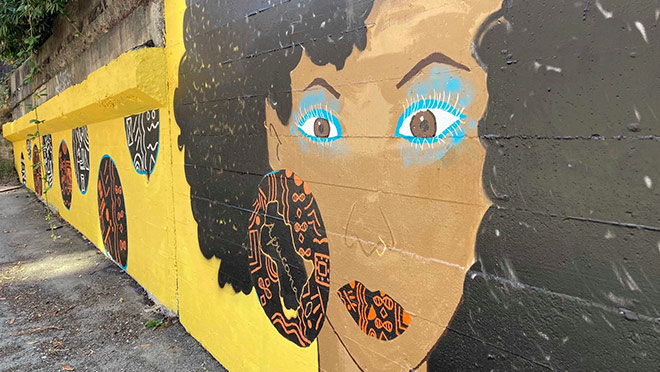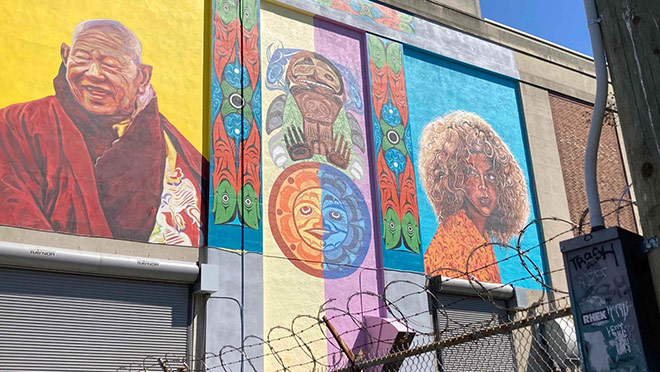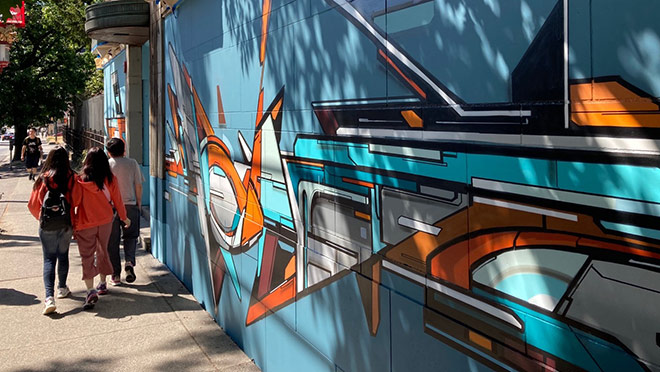Murrin substation murals help unveil Hogan's Alley history

Before viaducts erased it, multi-racial neighbourhood was a focus for Black community
Rob Klovance
For bchydro.com
As a kid growing up in East Vancouver, my knowledge of Black culture centred around my friendship with the coolest kid in my school. Henri Brown also happened to be the only Black kid at Graham Bruce Elementary, and – amazingly – is the cousin of guitar legend Jimi Hendrix. I knew that Henri's mom Pearl was a jazz singer and that Diana Ross was among Henri's star-studded list of family friends, but I didn't know anything about the Hogan's Alley community or the deep Hendrix connection to it.
Most of us living in Vancouver today, including those of us who grew up here, have had little or no knowledge of Hogan's Alley. But thanks in part to a number of stunning murals added for the Vancouver Mural Festival – including three on the exterior walls of BC Hydro's Murrin substation – that's changing.
On the substation's south wall is a mural that interweaves Chinese, Black and Indigenous culture in a collaborative work between three artists: Jie Xie, Chase Gray and John Sebastian. Other than viewing it from the alley behind the substation, the best way to see the mural is as you cross one of the two viaducts – Georgia and Dunsmuir – that link Strathcona to the downtown core. And there's irony there, as Hogan's Alley was largely destroyed by the construction of those viaducts.
Krystal Paraboo, project manager with the Vancouver Mural Festival, says her goal is to use the murals to push back against the erasure of the Black community in Strathcona. The festival runs through August 22, but the murals will remain.
"So far, the response to the murals has been phenomenal," Paraboo said a few days after the festival opened. "Even in the midst of the painting of the murals, so many people walking by later called to thank us. And they hadn't even seen the end product."

Black families and businesses once thrived in Hogan's Alley
You can read a fantastic history of Hogan's Alley at placesthatmatter.ca, but here's a brief summary.
Unofficially named sometime around 1914 for the T-shaped intersection at the southwestern edge of Strathcona, Hogan's Alley was an ethnically diverse neighbourhood and a nucleus for Black culture. It's recognized as the first and (so far) only community in Vancouver with a concentrated Black population, and was home to Black businesses, the city's only Black church (the African Methodist Episcopal Fountain Chapel), and – due to proximity of the CN Railroad terminus at Pacific Central Station – home to many porters who served CN passengers.
A Jimi Hendrix shrine stands at the corner of Main and Union streets in Vancouver as a reminder of the musician's connection to the community. As a boy he spent many summers in Hogan's Alley visiting his grandmother Nora, a cook at the former Vie's Chicken and Steakhouse, where the shrine is located. And one year, he attended Sir Wilson Dawson Annex elementary school in the West End.
Homes in Hogan's Alley were removed starting in 1967 to allow for construction of the viaducts, which were built as the first phase of a planned freeway through downtown Vancouver. The idea of a freeway was killed by the protests of area residents, and there are now plans to dismantle the viaducts as part of a renewal of the neighbourhood. Central to that is recognition of the area's Black history, in part through storytelling in murals featured in the Vancouver Mural Festival's Black Strathcona Resurgence Project.
A stone's throw from the Murrin substation is another mural fest art work. With 'Hope through Ashes: A requiem for Hogan's Alley', artist Anthony Joseph depicts a series of Black figures, including one holding one standing in front of a 'White Only' sign, over a vast 45-metre mural. That mural was done last year, but drew enough interest to inspire the Black Strathcona Resurgence Project (BSRP) as part of the mural fest.
"Ever since Anthony's mural went up last year, people have been reaching out saying things like 'I had no idea about the Black history of the neighbourhood, and I've live here my whole life'," said Paraboo.
Last year, only two of the more than 200 murals in the festival were done by Black artists. Paraboo knew there was talent out there that wasn't part of the fest, and the Black Strathcona Resurgence Project has helped diversify this year's lineup, with 11 murals by Black artists, and another three by Indigenous and Chinese artists.
The former Hogan's Alley area northeast of False Creek will be dramatically altered once the viaducts are removed. A new street system, larger parks, affordable housing and a new sustainable neighbourhood are planned. And work is already underway on the construction of the new St. Paul's hospital, which will replace the hospital's current Burrard Street location, in a spot sandwiched between Strathcona and Via Rail's Pacific Central Station.
The Hogan's Alley Society is lobbying the city to include a Black cultural centre as part of that renewal, envisioning it as a programming hub for "food, gathering and celebration, education and empowerment, art music and dance, and research and knowledge of Black Canadian history." At least 300 units of social housing are proposed for the area, and Paraboo says one developer is looking at giving Black families first right of refusal for units in at least one new residential building.
"It's not about ensuring that every single Black person in Vancouver needs to be living in one concentrated area," said Paraboo. "But just like there is a Chinatown, it would be great to revive an area that celebrates Black culture, that reminds people that Black people are here. It's about humanizing Black people again, so that instead of the story being about the suffering, we can reclaim it to be about celebrating the culture."

Three murals painted on BC Hydro's aging Murrin substation
BC Hydro is working to replace and upgrade aging infrastructure in Vancouver's power system. This includes a new underground substation in the West End to replace Dal Grauer Substation as early as 2028 as well as a future East Vancouver Substation to replace Murrin Substation. These aging substations need to be decommissioned as soon as possible as they're nearing end-of-life, are susceptible to significant damage from a major earthquake, and it's not practical to rebuild them where they are. For now, new colour has been added to Murrin substation in the form of three murals that are part of the mural festival.
The three-panel 'Solidarity Storytelling' mural on the south wall features a Tibetan meditation master, a Coast Salish design reflecting artist Chase Gray's Musqueam heritage, and an ode to the young Black women who are part of the Black Lives Matter movement.
On the building's north wall, almost right at ground level, is Enia Sitole's 'I Was Silent Until I Raised My Voice', which features a Black woman with a large Afro, her lips and earrings sporting a traditional design found in common African fabrics.
And on the east side is the largest work of the three, Toronto artist Mediah's 'Habesha Prichorde', a futuristic depiction that draws on the colours portraying the diversity of African-Caribbean cultures.